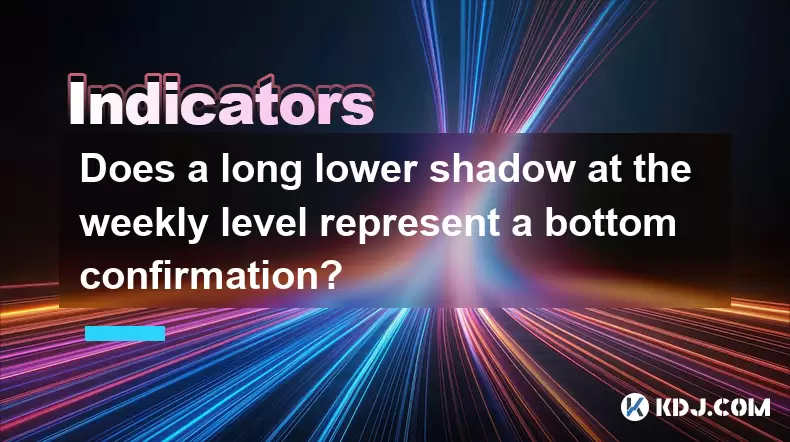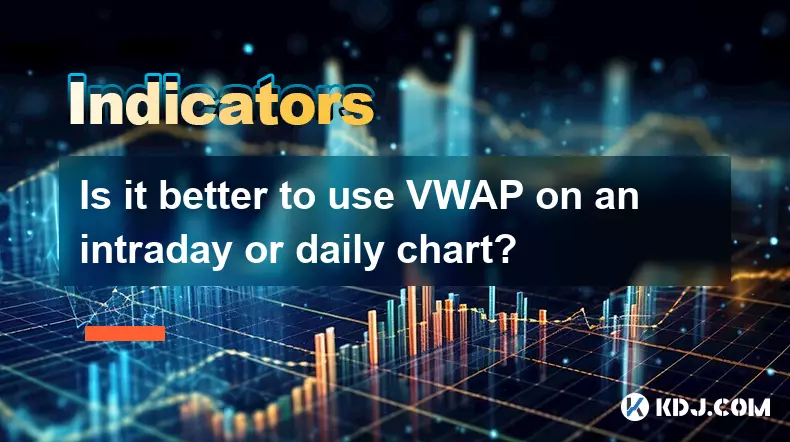-
 bitcoin
bitcoin $110918.433029 USD
-1.69% -
 ethereum
ethereum $3996.872473 USD
-2.43% -
 tether
tether $1.000594 USD
0.00% -
 bnb
bnb $1178.871834 USD
-2.38% -
 xrp
xrp $2.413973 USD
-3.47% -
 solana
solana $194.341461 USD
-4.24% -
 usd-coin
usd-coin $0.999963 USD
-0.03% -
 tron
tron $0.320092 USD
0.92% -
 dogecoin
dogecoin $0.196919 USD
-3.42% -
 cardano
cardano $0.669585 USD
-3.63% -
 hyperliquid
hyperliquid $37.485952 USD
-3.58% -
 ethena-usde
ethena-usde $1.000026 USD
-0.02% -
 chainlink
chainlink $18.018220 USD
-5.13% -
 bitcoin-cash
bitcoin-cash $523.879267 USD
-2.41% -
 stellar
stellar $0.324655 USD
-3.67%
Does a long lower shadow at the weekly level represent a bottom confirmation?
A long lower shadow on a weekly candle may signal weakening selling pressure, but confirmation through volume and follow-through is crucial for traders seeking reliable reversals.
Jun 27, 2025 at 10:56 am

Understanding the Weekly Lower Shadow in Candlestick Analysis
In cryptocurrency trading, weekly candlestick patterns are often scrutinized for potential trend reversals. A long lower shadow at the weekly level indicates that during the week, sellers pushed prices down significantly but were met with strong buying pressure that closed the candle near its opening price or higher. This pattern is commonly interpreted as a sign of potential bullish reversal, especially if it appears after a prolonged downtrend.
However, while this formation can be promising, it should not be viewed in isolation. Traders must cross-verify such signals using other technical indicators and volume analysis to confirm whether a bottom is indeed forming.
Important: The presence of a long lower shadow does not guarantee a reversal—it merely suggests that selling pressure may be weakening.
Historical Context: Long Lower Shadows and Market Reversals
Looking back at historical Bitcoin and Ethereum charts, there have been instances where a long lower shadow on the weekly chart preceded significant rallies. For example, during the 2018–2019 bear market, Bitcoin formed a long-legged doji with a deep lower shadow on the weekly timeframe, which later marked the beginning of a new bull phase.
These occurrences suggest that when institutional or large retail buyers step in after heavy selloffs, they absorb the selling pressure and push prices back up, creating a visible rejection of lower levels. However, it's crucial to note that such formations often require time and additional confirmation signals before a full-fledged reversal occurs.
- Look for increased volume during the formation of the lower shadow
- Check for confluence with key support levels, such as previous resistance zones or Fibonacci retracements
- Monitor moving averages—a retest of the 200-week moving average with a long lower shadow can be particularly significant
Differentiating Between a Fakeout and a Genuine Bottom Signal
Not every long lower shadow leads to a sustainable reversal. In highly volatile crypto markets, false signals are common. Sometimes, whales or bots manipulate the price to trigger stop losses before reversing sharply upward, creating what's known as a **'fake break.'
To distinguish between a fakeout and a genuine signal:
- Examine wick size relative to body size—the longer the shadow compared to the real body, the stronger the rejection
- Analyze order book depth to see if there was actual liquidity absorption at those lower levels
- Observe follow-through in subsequent weeks—a true reversal usually sees higher closes and bullish momentum continuing into the next candles
A single candle, no matter how impressive, cannot confirm a bottom without follow-through from the broader market structure.
Combining Weekly Signals with Daily and 4-Hour Charts
For traders seeking more precise entries, aligning the weekly long lower shadow with setups on shorter timeframes can improve accuracy. If the weekly candle shows a strong rejection of lows, traders might look for bullish engulfing patterns or hammer formations on the daily or 4-hour charts to enter positions with tighter stops.
This multi-timeframe approach allows traders to benefit from both the macro-level sentiment and micro-level timing. Additionally:
- Use RSI divergence on the daily chart to assess whether momentum supports a reversal
- Watch for accumulation patterns like ascending triangles or cup-and-handle formations
- Set stop-losses below the shadow’s low if entering based on the weekly signal
Such integration helps avoid premature entries and increases the probability of catching a legitimate trend reversal.
Common Pitfalls When Interpreting Weekly Shadows
Many novice traders fall into the trap of overreacting to a single candlestick formation. It's easy to get excited when a long lower shadow appears on the weekly chart, especially after a painful downtrend. However, several pitfalls can lead to poor decision-making:
- Misinterpreting volatility as strength—a sharp drop followed by a quick bounce doesn’t always mean a bottom is in
- Neglecting broader market conditions—if altcoins or equities are still under pressure, Bitcoin might not sustain a rally even with a bullish candle
- Failing to adjust risk parameters—traders sometimes take oversized positions based on hopeful assumptions rather than confirmed trends
Avoiding these mistakes requires discipline and a structured trading plan that incorporates multiple layers of analysis.
FAQs
Q: Can a weekly hammer candle alone confirm a bottom?A: No, a hammer candle—even on the weekly chart—should be used in conjunction with other tools such as volume, trendlines, and oscillator readings to increase confidence in a reversal.
Q: How long should I wait for confirmation after seeing a long lower shadow?A: Typically, one to two weeks of follow-through price action above the hammer’s close provides stronger evidence that the market has accepted the new value area.
Q: Are long lower shadows more reliable in certain market cycles?A: These signals tend to be more reliable after extended bear markets or during capitulation phases, where emotional selling exhaustion is likely.
Q: Should I use leverage when trading off a weekly long lower shadow?A: Leverage should be used cautiously. Given the size of weekly candles, slippage and liquidation risks increase, especially in less liquid altcoins.
Disclaimer:info@kdj.com
The information provided is not trading advice. kdj.com does not assume any responsibility for any investments made based on the information provided in this article. Cryptocurrencies are highly volatile and it is highly recommended that you invest with caution after thorough research!
If you believe that the content used on this website infringes your copyright, please contact us immediately (info@kdj.com) and we will delete it promptly.
- Cryptos in Flux: MoonBull's Lunar Stampede, Solana's Struggle, and XRP's ETF Hopes
- 2025-10-17 06:25:11
- Remittix Presale, RTX Token, and DeepSnitch AI: The Next Big Thing in Crypto?
- 2025-10-17 07:25:17
- Bitcoin, Trump & Meme Coins: Newsmax's Bold Move & AlphaPepe's Rise
- 2025-10-17 07:25:17
- SEI Forms Inverse Head & Shoulders: Breakout Imminent?
- 2025-10-17 07:10:01
- Cardone Capital Dives Deeper: Why Grant Cardone is Buying More Bitcoin Now
- 2025-10-17 06:25:11
- Newsmax, Bitcoin, and Trump Coin: A Bold Crypto Play?
- 2025-10-17 07:10:01
Related knowledge

What's the main difference between VWAP and TWAP?
Oct 12,2025 at 11:54am
Understanding VWAP and Its Role in Crypto Trading1. Volume Weighted Average Price (VWAP) is a trading benchmark that calculates the average price of a...

How do you identify exhaustion moves using VWAP and its bands?
Oct 12,2025 at 08:00am
Understanding the Role of Decentralized Exchanges in Crypto Trading1. Decentralized exchanges (DEXs) operate without a central authority, allowing use...

Is it better to use VWAP on an intraday or daily chart?
Oct 15,2025 at 02:01am
Intraday Trading and the Role of VWAP1. Intraday traders frequently rely on VWAP (Volume Weighted Average Price) as a dynamic benchmark for assessing ...

How do you use VWAP to scale in and out of positions?
Oct 14,2025 at 02:19am
Understanding VWAP as a Dynamic Benchmark1. The Volume Weighted Average Price (VWAP) is not just an indicator—it functions as a dynamic benchmark that...

What are the main advantages of using VWAP over EMA?
Oct 11,2025 at 02:18am
Main Advantages of Using VWAP Over EMA1. Volume-Weighted Average Price (VWAP) incorporates trading volume into its calculation, offering a more accura...

How do you use VWAP on different chart types like Heikin Ashi?
Oct 11,2025 at 05:01pm
Understanding VWAP in the Context of Heikin Ashi Charts1. The Volume Weighted Average Price (VWAP) is a powerful analytical tool commonly used by trad...

What's the main difference between VWAP and TWAP?
Oct 12,2025 at 11:54am
Understanding VWAP and Its Role in Crypto Trading1. Volume Weighted Average Price (VWAP) is a trading benchmark that calculates the average price of a...

How do you identify exhaustion moves using VWAP and its bands?
Oct 12,2025 at 08:00am
Understanding the Role of Decentralized Exchanges in Crypto Trading1. Decentralized exchanges (DEXs) operate without a central authority, allowing use...

Is it better to use VWAP on an intraday or daily chart?
Oct 15,2025 at 02:01am
Intraday Trading and the Role of VWAP1. Intraday traders frequently rely on VWAP (Volume Weighted Average Price) as a dynamic benchmark for assessing ...

How do you use VWAP to scale in and out of positions?
Oct 14,2025 at 02:19am
Understanding VWAP as a Dynamic Benchmark1. The Volume Weighted Average Price (VWAP) is not just an indicator—it functions as a dynamic benchmark that...

What are the main advantages of using VWAP over EMA?
Oct 11,2025 at 02:18am
Main Advantages of Using VWAP Over EMA1. Volume-Weighted Average Price (VWAP) incorporates trading volume into its calculation, offering a more accura...

How do you use VWAP on different chart types like Heikin Ashi?
Oct 11,2025 at 05:01pm
Understanding VWAP in the Context of Heikin Ashi Charts1. The Volume Weighted Average Price (VWAP) is a powerful analytical tool commonly used by trad...
See all articles










































































